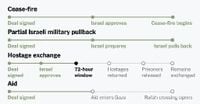As dawn broke on October 10, 2025, a sense of cautious hope swept across the Gaza Strip. After two years of relentless conflict that had left Gaza in ruins, a U.S.-brokered ceasefire between Israel and Hamas finally came into effect, prompting tens of thousands of Palestinians to make their way back to the devastated northern regions of the enclave. For many, the journey home was both a physical and emotional odyssey—returning not to the houses and neighborhoods they once knew, but to fields of rubble and shattered memories.
The ceasefire, which marks the initial phase of U.S. President Donald Trump’s peace plan, has sparked a wave of relief and tentative optimism throughout the region. According to the Associated Press, the agreement stipulates that all remaining hostages—48 in total, with about 20 believed to be alive—are to be released by October 13. In exchange, Israel plans to free around 2,000 Palestinian prisoners, though the list notably excludes high-profile detainees such as Marwan Barghouti, a figure regarded by many Palestinians as a potential unifying leader.
Israeli Prime Minister Benjamin Netanyahu addressed the nation on the day the ceasefire began, underscoring the conditions of the truce. “The next stages would see Hamas disarm and Gaza demilitarized. If this is achieved the easy way—so be it. If not—it will be achieved the hard way,” Netanyahu declared, as reported by AP. The Israeli military, while confirming the start of the ceasefire, stated it would maintain a defensive posture in roughly half of Gaza, having pulled back to agreed-upon lines.
For the people of Gaza, the immediate reality is grim. The war, which erupted on October 7, 2023, after a Hamas-led assault killed approximately 1,200 Israelis and resulted in the capture of 251 hostages, has since claimed over 67,000 Palestinian lives and wounded nearly 170,000 more, according to Gaza’s Health Ministry. The United Nations and independent experts have cited these figures as the most reliable estimates, though the ministry does not distinguish between civilian and combatant casualties. The destruction has been so extensive that nearly 90% of Gaza’s two million residents have been displaced—many more than once.
As Palestinians streamed northward along the battered coastal roads, their return was marked by a mix of relief, anxiety, and profound loss. “There wasn’t much joy, but the ceasefire somewhat eased the pain of death and bloodshed, and the pain of our loved ones and brothers who suffered in this war,” said Jamal Mesbah, a displaced resident interviewed by AP. In Khan Younis, a southern city that saw intense fighting, Fatma Radwan described the devastation: “There was nothing left. Just a few clothes, pieces of wood and pots.” Hani Omran, also returning to Khan Younis, lamented, “We came to a place that is unidentifiable ... Destruction is everywhere.”
The ceasefire has also brought a flurry of humanitarian activity. The United Nations, having received authorization from Israel, is set to begin delivering scaled-up aid shipments starting October 12. According to a U.N. official who spoke with AP, 170,000 metric tons of supplies—stockpiled in neighboring Jordan and Egypt—are ready to enter Gaza. Fuel, medical supplies, and other essentials began flowing through the Kerem Shalom crossing, but U.N. humanitarian chief Tom Fletcher cautioned that in recent months, only about 20% of the needed aid had reached the Strip due to ongoing hostilities and restrictions.
For medical workers on the ground, the challenges remain daunting. In an interview with Foreign Policy, Mathieu Bichet, deputy medical director at Doctors Without Borders (MSF), described the atmosphere among his team at a field hospital in Deir al-Balah: “The team today is quite happy and hopeful regarding the cease-fire. That was on everybody’s face this morning, this afternoon. But then we are also grieving our two colleagues who died recently.” Bichet detailed the acute shortages of basic medical supplies—sterile gauze, medication, bandages—and the logistical nightmare of securing safe passage for both aid and patients. “The complexity of having a channel of supply is definitely a huge challenge for all the health workers here. That’s clear,” he said.
The humanitarian crisis extends beyond medical needs. Severe malnutrition and famine conditions, declared by the U.N. in August 2025, have compounded the suffering. “There are kids who are malnourished,” Bichet noted, adding that the price of food remains prohibitively high even in less-damaged southern markets. The psychological toll is equally severe. “If it was just about us, we would stay at home and cry, but we are waking up in the morning just to do our job because patients are there and this is what we need to do. So, they continue. They tell us that working is their way to cope. They are really heroes who are working every day,” Bichet shared, reflecting on the resilience of local health workers.
While the ceasefire has brought a measure of hope, uncertainty lingers over the future governance of Gaza and the durability of peace. The Trump plan, as outlined by AP, envisions Israel maintaining an open-ended military presence along Gaza’s border, with an international force—largely from Arab and Muslim countries—providing internal security. The U.S. would spearhead a massive reconstruction effort, but the plan’s requirements for sweeping reforms in the Palestinian Authority and its ambiguity regarding a future Palestinian state have left many skeptical.
Meanwhile, the ceasefire has resonated far beyond the Middle East. In Manitoba, Canada, the agreement has been a moment of intense anticipation for many with family ties to Gaza. As reported by local outlets, efforts are underway to bring relatives from Gaza to the province, though persistent visa challenges have complicated reunification.
As families across Gaza sift through debris in search of belongings and closure, the international community watches closely. The ceasefire is a critical step, but as Bichet and others on the ground emphasize, the path to recovery is long and fraught with obstacles. The wounds of war—physical, emotional, and societal—will not heal overnight, and the question of what comes next remains as pressing as ever.
For now, amid the ruins and uncertainty, the people of Gaza cling to hope that this fragile peace might hold, and that the world will not look away as they begin the arduous task of rebuilding their lives.





